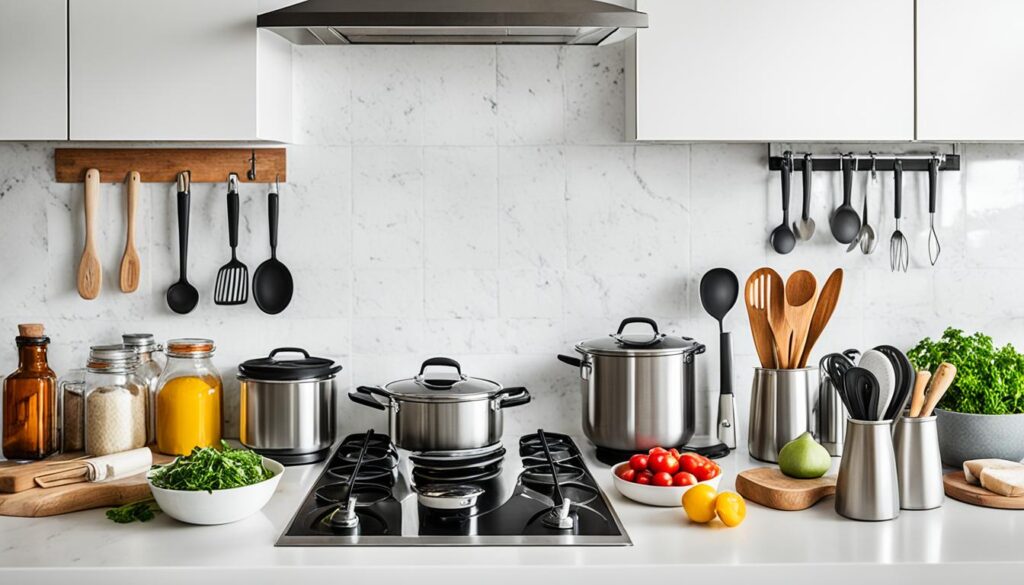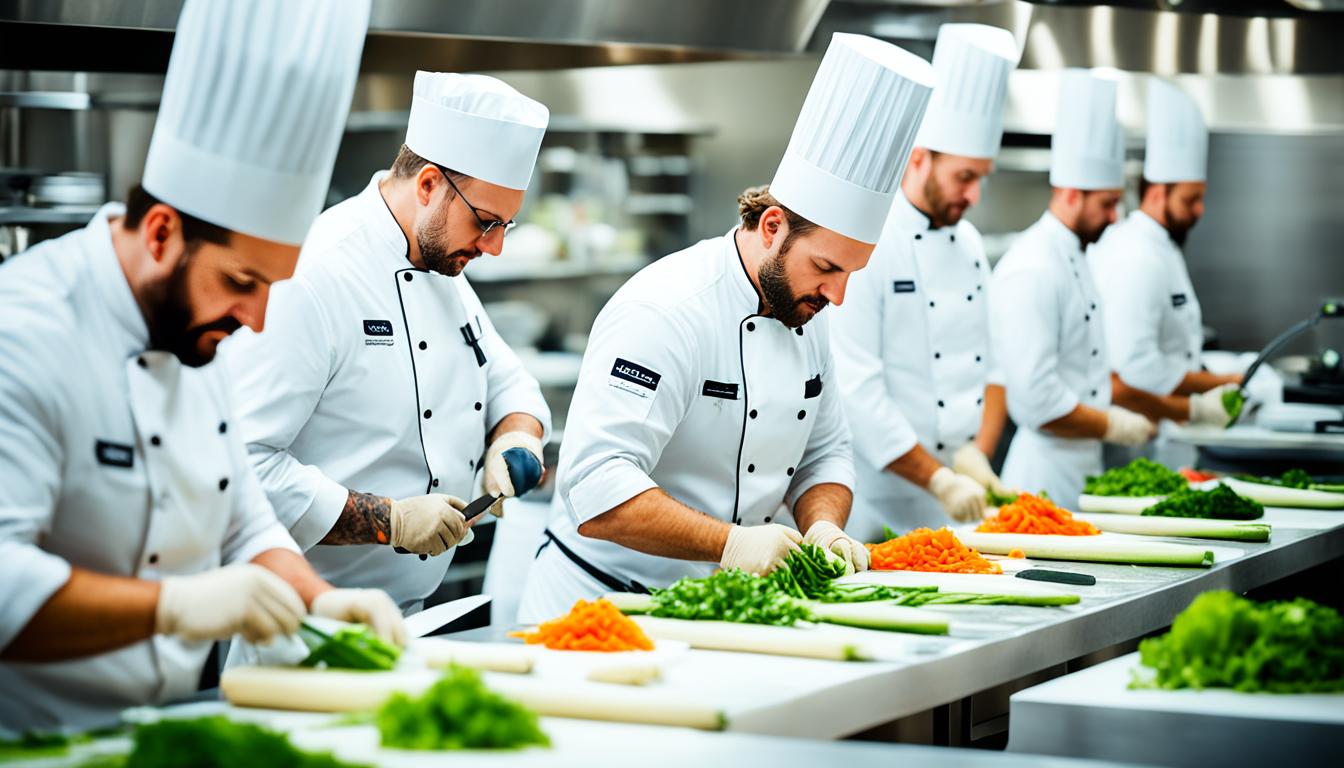Welcome to our Mise en Place Round Up, where we delve into the world of kitchen organization and efficient meal prep. Have you ever wondered how professional chefs manage to create culinary masterpieces in record time? Or how they keep their kitchens seamlessly organized amidst the chaos of cooking? Join us as we explore the secrets behind the culinary workflow, chef organization strategies, and kitchen time management techniques that streamline the cooking process.
The Importance of Mise en Place in Professional Kitchens
Mise en place is not merely a technique; it is the backbone of a well-organized and efficient professional kitchen. This culinary workflow strategy ensures that every ingredient and tool is in its rightful place, ready to be utilized with precision and speed. The significance of mise en place cannot be overstated, as it directly impacts food production, waste management, and overall chef organization strategies.
Renowned chef Auguste Escoffier, often referred to as the “Father of Modern Cuisine,” recognized the value of mise en place and revolutionized the culinary industry through his standardized approach to cooking. By implementing this method, Escoffier transformed chaotic kitchens into harmoniously functioning spaces where chefs could perform at their best. Today, professional chefs across the world continue to uphold the tradition and legacy of mise en place.
At its core, mise en place fosters a meticulous level of organization within a professional kitchen. By prepping and arranging all ingredients in advance, chefs can focus on the cooking process without interruptions or distractions. This streamlined approach allows for faster and more accurate execution of dishes, ensuring quicker turnaround times and superior quality. It also minimizes the likelihood of errors and mishaps, maintaining a high standard of culinary excellence.
“In a professional kitchen, mise en place is like a symphony orchestra following a conductor’s lead. It embodies efficiency, harmony, and precision, resulting in culinary masterpieces.” – Chef James Williams
Mise en place also plays a crucial role in minimizing waste. By having all ingredients measured and prepped in advance, chefs can avoid overusing or discarding excess ingredients during the cooking process. This mindful approach to ingredient management aligns with sustainable practices and supports environmentally conscious culinary ventures.
The Culinary Workflow in Action
Let’s see how mise en place enhances the culinary workflow in a professional kitchen:
| Stage of Culinary Workflow | Mise en Place Benefits |
|---|---|
| Recipe Analysis and Planning |
|
| Ingredient Procurement |
|
| Preparation and Prepping |
|
| Cooking and Plating |
|
| Cleaning and Resetting |
|
Adopting professional kitchen techniques like mise en place facilitates a well-structured workflow, empowering chefs to manage their time effectively and maintain a high level of culinary excellence.
In the next section, we will explore the ongoing debate surrounding the application of mise en place in home kitchens. While it is crucial in the professional culinary world, does it hold the same significance in everyday cooking? Let’s dig deeper to find out.
The Debate: Mise en Place in Home Kitchens
When it comes to implementing the mise en place technique in home kitchens, opinions are divided. Some argue that adopting this method can offer valuable benefits such as saving time, while others question its necessity for everyday cooking. Ultimately, efficient meal prep and kitchen organization techniques can vary based on individual cooking styles, recipe complexity, and personal preferences.
For those in favor of mise en place, the practice of gathering and prepping ingredients in advance can help streamline the cooking process. By assembling all the necessary ingredients and tools before starting the actual cooking, you can work more efficiently, minimizing distractions and potential mistakes. It also allows for better time management in the kitchen, especially when preparing complex recipes or multitasking.
“The key to success in the kitchen is organization. Mise en place is the foundation of this organization, helping us save time as we navigate through the cooking process.”
– Chef Marie Smith
On the other hand, some home cooks find the concept of mise en place unnecessary or impractical for their daily cooking routines. They argue that for simpler recipes or when cooking familiar dishes, it might be more efficient to gather and prep ingredients as you progress through the recipe. This approach allows for a more flexible and spontaneous cooking experience, enabling adjustments and improvisation along the way.
Ultimately, whether or not to employ mise en place in home cooking is a matter of personal preference and practicality. It’s important to consider your own cooking style, the complexity of the recipes you frequently prepare, and the overall time management strategies that work best for you.
Efficient Kitchen Organization Tips
To maximize productivity and reduce cooking time, even without strictly adhering to mise en place, consider these efficient kitchen organization tips:
- Create a well-organized pantry and fridge to easily locate ingredients.
- Prioritize cleaning and tidying as you work to maintain an organized workspace.
- Invest in storage containers and labeling systems to keep ingredients easily accessible and prevent waste.
- Group similar items together to streamline ingredient retrieval during cooking.
- Utilize time-saving kitchen tools and gadgets to expedite meal prep tasks.
Remember, the goal is to optimize your kitchen workflow, enhance meal preparation efficiency, and enjoy the process of cooking. Whether you choose to incorporate mise en place or adopt alternative strategies, finding the perfect balance of organization and creativity in your home kitchen will ultimately lead to more enjoyable and successful cooking experiences.
Factors to Consider for Mise en Place in Home Cooking
When it comes to implementing the technique of mise en place in home cooking, several factors play a crucial role in determining its effectiveness. By considering these factors, you can make an informed decision about whether to adopt this method in your own kitchen.
The Complexity of the Recipe
One of the primary factors to consider is the complexity of the recipe you are planning to prepare. Recipes with multiple ingredients and intricate steps may benefit greatly from mise en place. By gathering and prepping all the necessary ingredients and tools in advance, you can ensure a smoother cooking process.
Cooking Time
The length of time required to cook a dish also influences whether mise en place is a suitable approach for your kitchen. If the cooking time is relatively short, the need for extensive prepping and organization may be minimal. On the other hand, recipes that involve longer cooking times can provide opportunities to prep ingredients while others are cooking.
Simultaneous Prep and Cooking Needs
Consider whether your recipe requires simultaneous prep and cooking. Some dishes may require ingredients to be added at specific intervals or cooked for different durations. In these cases, mise en place can help ensure that all components are ready when needed, streamlining the cooking process and improving efficiency.
By taking these factors into account, you can determine the best approach to kitchen organization, efficient meal prep, and streamlining the cooking process. Mise en place can be a valuable technique for certain recipes, but it may not always be necessary or practical for every home cook. Experiment and find the method that works best for you, ensuring your cooking experience is enjoyable and stress-free.

Alternatives to Mise en Place
While Mise en Place is a traditional approach to prepping for cooking, it may not always be the most efficient method for every home cook. We understand that everyone has their own kitchen organization tips and preferences for efficient meal prep. With that in mind, here are some alternative strategies that can help streamline the cooking process and achieve kitchen organization:
1. Overlapping Prep Steps
One alternative to Mise en Place is overlapping prep steps. This involves multitasking and prepping ingredients while others are cooking. For example, while your onions are sautéing, you can chop the vegetables for your salad or marinate the chicken for tomorrow’s dinner. By efficiently utilizing your time, you can maximize productivity in the kitchen.
2. Adaptability in Recipe Reading
Another alternative is to adapt your recipe reading approach. Instead of following the recipe step-by-step, you can read the entire recipe before you start cooking. This allows you to identify any repetitive or time-consuming steps that can be simplified or eliminated. By understanding the overall process, you can better plan your prep and cooking tasks to optimize efficiency.
3. Prioritizing Tasks Based on Cooking Times and Techniques
Prioritizing tasks based on cooking times and techniques can also help streamline the cooking process. Focus on tasks that require your immediate attention, such as preheating the oven or boiling water, while you work on preparing other ingredients. By strategically organizing your tasks, you can ensure that everything is ready when you need it, reducing any unnecessary downtime.
Using these alternative strategies can help you achieve efficient meal prep and streamline the cooking process, even if you choose not to follow the traditional Mise en Place approach. Remember, the goal is to find a method that works best for you and allows you to create delicious meals with ease.
| Traditional Mise en Place | Alternative Strategies |
|---|---|
| Requires extensive prep before cooking | Allows for multitasking and overlapping prep steps |
| Strict adherence to recipe instructions | Adapts recipe reading to optimize efficiency |
| Organizes ingredients in advance | Prioritizes tasks based on cooking times and techniques |
| Promotes high level of organization | Offers flexibility and customization |
Conclusion
In conclusion, mise en place is a widely recognized technique in professional kitchens that aims to optimize workflow and ensure efficient cooking processes. While its relevance and applicability in home kitchens may vary, the goal of achieving kitchen organization, efficient meal prep, and a streamlined cooking process remains the same.
Whether one chooses to adopt the traditional mise en place method or explore alternative strategies, such as overlapping prep steps or prioritizing tasks based on cooking times, it is important to find the approach that works best for each individual cook. Experimentation and flexibility are key in determining the most effective kitchen organization techniques and efficient meal prep methods.
By considering factors such as recipe complexity, cooking time, and personal preferences, home cooks can tailor their approach to achieve the desired results. The ultimate aim is to optimize time management, minimize waste, and enhance the overall cooking experience.
So, whether you prefer the structured approach of mise en place or opt for alternative strategies, the primary goal is to create a well-organized and efficient kitchen environment that enables you to enjoy the art of cooking while maximizing your culinary skills.
